The terms ‘pressing’ and Everton Women have become synonymous in this season’s FAWSL. In Willie Kirk’s past year in charge of the toffees, he has managed to transform Everton from a team who were fighting relegation last season to a team competing as leaders of the mid-table. A key factor to their rise in form has been the way they press as part of their defensive organisation. With the FAWSL at halt along with major leagues around the world, it is time to look closer at Everton women’s pressing tactics and how Willie Kirk has been perfecting it throughout this season.
This tactical analysis scout report will break down Everton’s pressing tactics and use analysis to understand how their defensive system works in different phases of the game.
System and defensive game model
The most common formation used by Willie Kirk with Everton women is the 4-2-3-1. Although he tried the 4-5-1 and the 4-4-1-1 in the initial games of this season, the 4-2-3-1 is the one that manifests his principles of play most distinctly.
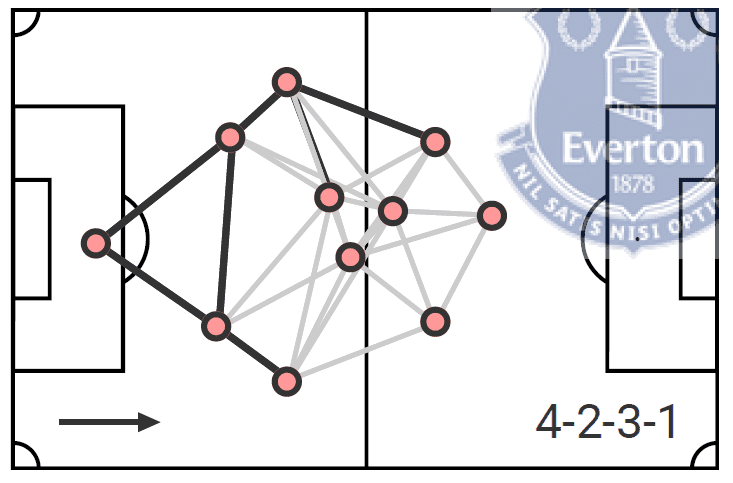
The 4-2-3-1 has four lines of pressure. The first line of the press begins with the centre forward, which can be played by Simone Magill, Chloe Kelly or Hannah Cain. The primary role of the centre forward is to add pressure on the deepest opposition player that receives the ball while building out of the back. When the centrebacks pass the ball to each other, the centre forward also makes angled runs to break the passing lane. With intelligent timing of the press, she can force the play onto a corner of the pitch and cut out the passing angles to the back forcing the ball long or out of play.
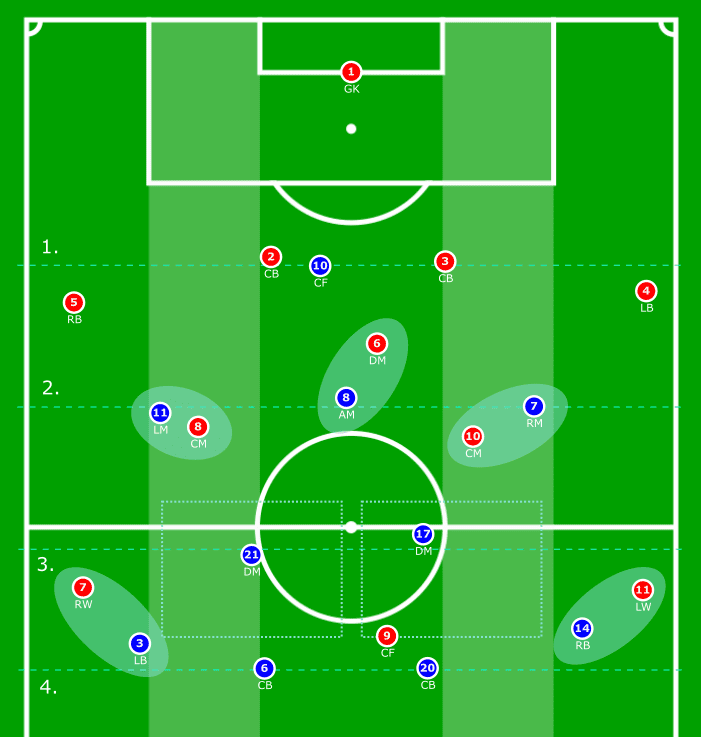
The second line of the press is led by the central attacking midfielder, usually played by Inessa Kaagman or Molly Pike. The preliminary objective is to man-mark the opposition pivot who plays in front of the defensive line. The attacking midfielder can also support the centre forward if she drifts out of position while pressing.
The two lateral midfielders in the attack can function as wingers when in possession, but out of possession their role is to support the central attacking midfielder in cutting the passing lanes through the centre. They engage in a man-oriented press when the opposition plays with two pivots or mark the half-spaces zonally in other instances. Everton have Chantelle Boye-Hlorkah, Kelly and Kaagman for these positions.
The third line of the press is covered by the two defensive midfielders who are usually assigned to mark the space in front of the defensive line zonally. It is Maéva Clémaron, Abbey-Leigh Stringer and skipper Lucy Graham who fill in these roles. Aside from winning most of the aerial duels, their job is to intercept the penetrating passes to the striker. They also push up aggressively when the pass is played back by the opposition leading the cue for the defensive line behind them to push up.
The final line is the defensive line which picks the right opportunity to pull the line higher closing the space for the opposition forwards to operate. The central defenders, Gabrielle George, Megan Finnigan and Kika van Es are brave to play with the centre forward on their shoulder. The fullbacks Danielle Turner on the left and Esme Morgan or Taylor Hinds on the right have a lot of mobility to break the line and put pressure on a wide opposition player about to receive the ball, especially when the play is forced wide to one side.
Now let’s look at specific instances in the game and how Everton work their press.
Defensive line as a pressing tool
All of Everton women’s games this season have involved 90 minutes intense pressing from all 10 outfield players chasing their markers down relentlessly. However, it’s not just the high-octane press that the players engage in, it’s the tactical intelligence in closing down the space for the opposition to play. The best tool to close the space from the back is the defensive line.
It is incorrect to claim that the high defensive line is part of Everton’s defensive organisation. They pick the right moments to force the opposition to play backwards towards their own goal and use this opportunity to push the line as high as they can from the back.
In this scheme below we see a pass played back by the opposition from the midfield to the free right back. She is deliberately left unmarked, as we elaborated earlier, but in this moment Everton try and ensure she doesn’t find an easy forward pass. Firstly, she is pressed immediately by the left midfielder, while the left-back closes in on the immediate passing option to the opposition right winger. The two defensive midfielders engage in a man-oriented press in the middle and the central attacking midfielder marks the opposition pivot.
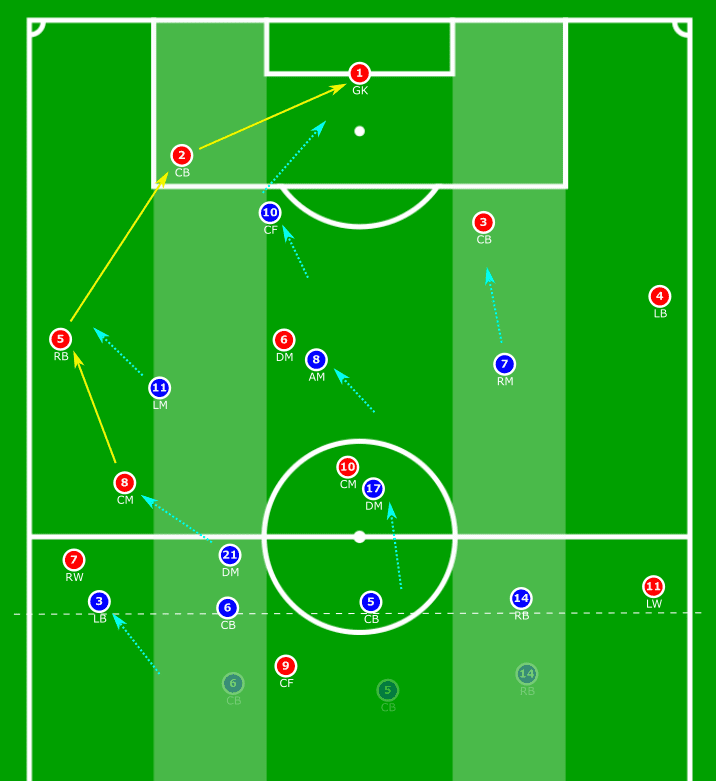
This forces the play back to the free centre half. Now the centre forward is already positioned waiting to begin pressing the ball all the way to the keeper with an angled run. This is the cue for the defensive line to push up from the bottom, closing in crucial square yards of space that the opposition would look to exploit trying to build out from the back again. With each player marking an opponent, the keeper is forced to play the ball long.
This is how Everton women turn a mid-block into a high press. They try and repeatedly force the play backwards closing all the options in the centre and leaving the fullbacks or centre-halves isolated.
Isolating the opposition fullbacks
One of the key features of Everton’s press against most teams is how they set traps for the opposition fullbacks. They often leave the fullbacks unmarked as the only free player to receive the ball in wide areas. Once the fullback receives the ball, Everton close down all options through the middle and hold the high line forcing the fullback to either play back or play a long-ball behind the high defensive line. Everton average the second-highest number of aerial duels (34.12) with a 53% success rate, just behind Reading, who have a lower success rate of 43%. This shows that they are quite successful in winning the long balls and are fair to force their opponents into playing them.
In this graphic we see a buildup from the back, the opposition goalkeeper passes to the centreback who then plays it to the right back. Everton’s centre forward begins the pressing move from the top by making an angled run to the centre back splitting her from her defensive partner on the other side. The central attacking midfielder (8) marks the pivot (6) while the wide midfielder tucks inside to mark the number 10.
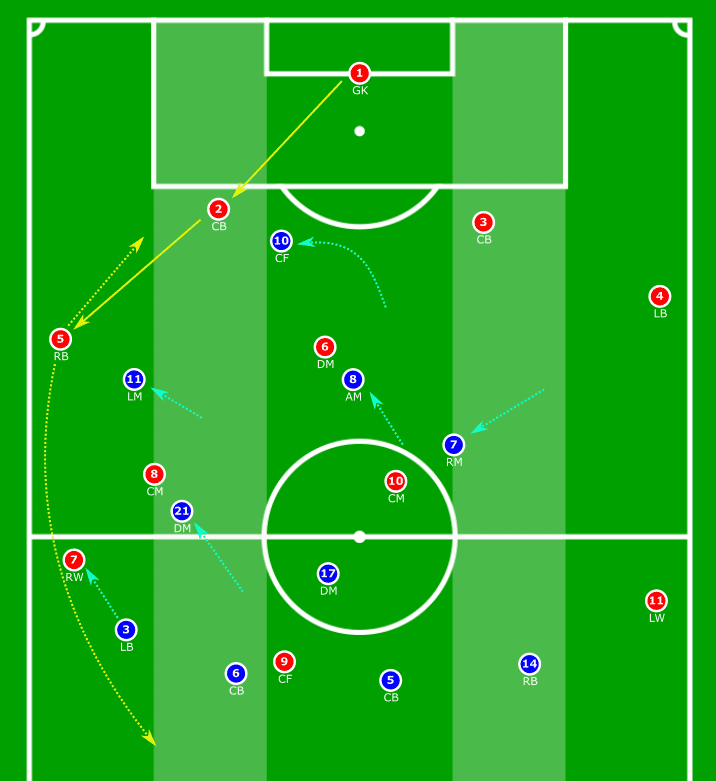
One of the defensive midfielders (21) pushes up to mark the number 8 from the opposition while Everton’s left-back (3) breaks away from the defensive line to close in on the right winger (7). Thus all the options for the right-back have been closed down by man-to-man pressing. She is left with two options now – to either play the ball back to her centre back who passed it to her, or look for the striker with a long ball in behind the defence. The high defensive line by Everton makes it incredibly difficult to play the second option without coordination and timing. This is a classic Everton pressing trap for opposition fullbacks.
Here we see an instance in the game against Manchester City, where the right-back from City is left with no options but to play the pass back. Notice the man-marking in the centre and the positioning of Magill, Everton’s centre forward to split City’s centre-halves. The right-back can play it to the centre back close to her, in which case they will get isolated on the same side because Everton’s positioning. The only other option would be to risk a horizontal pass to the other centre back away from her which will get the ball out of the overload on her side, but an interception could result in a dangerous counter-attack.
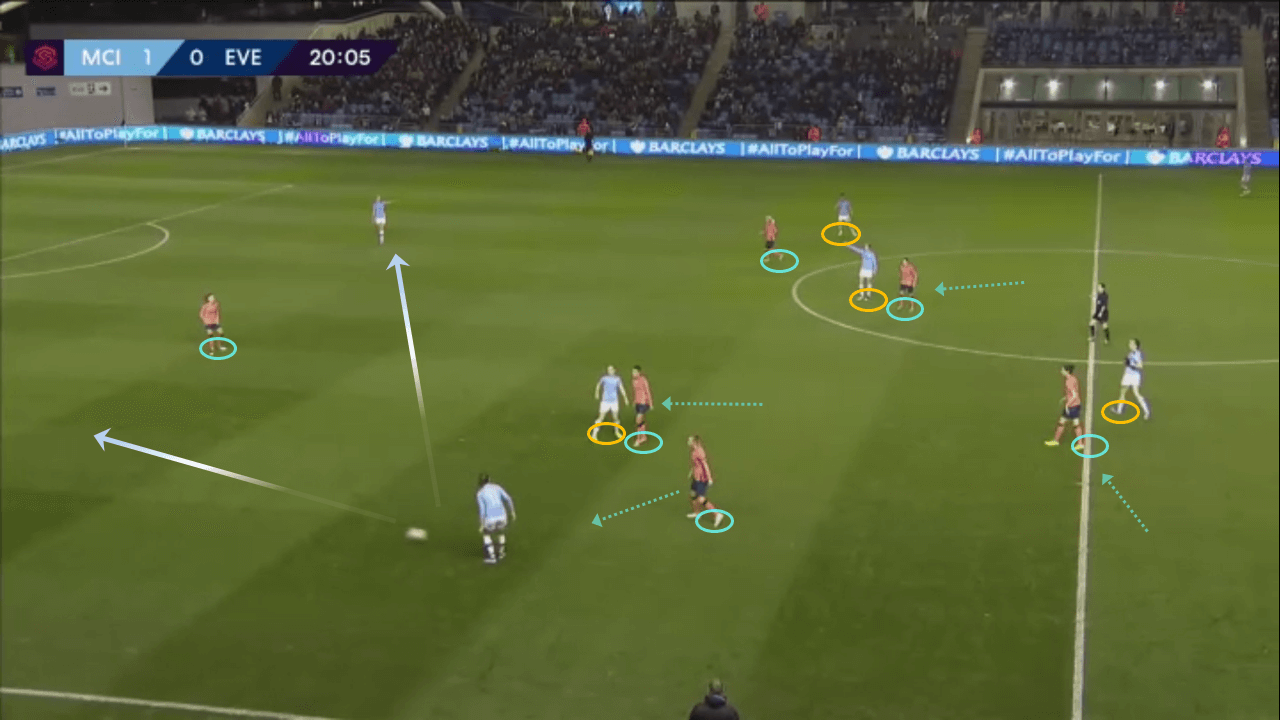
In this game against Manchester United, we see how Everton aggressively presses up on a backpass. Kelly, the forward in this moment is positioned to split the United central defenders. Graham is man-marking the pivot in front of the defence. Kaagman the left midfielder and Stringer, the defensive midfielder press back the United defenders 2v2 while Turner, the left-back pushes up to create a numerical superiority forcing the play out.
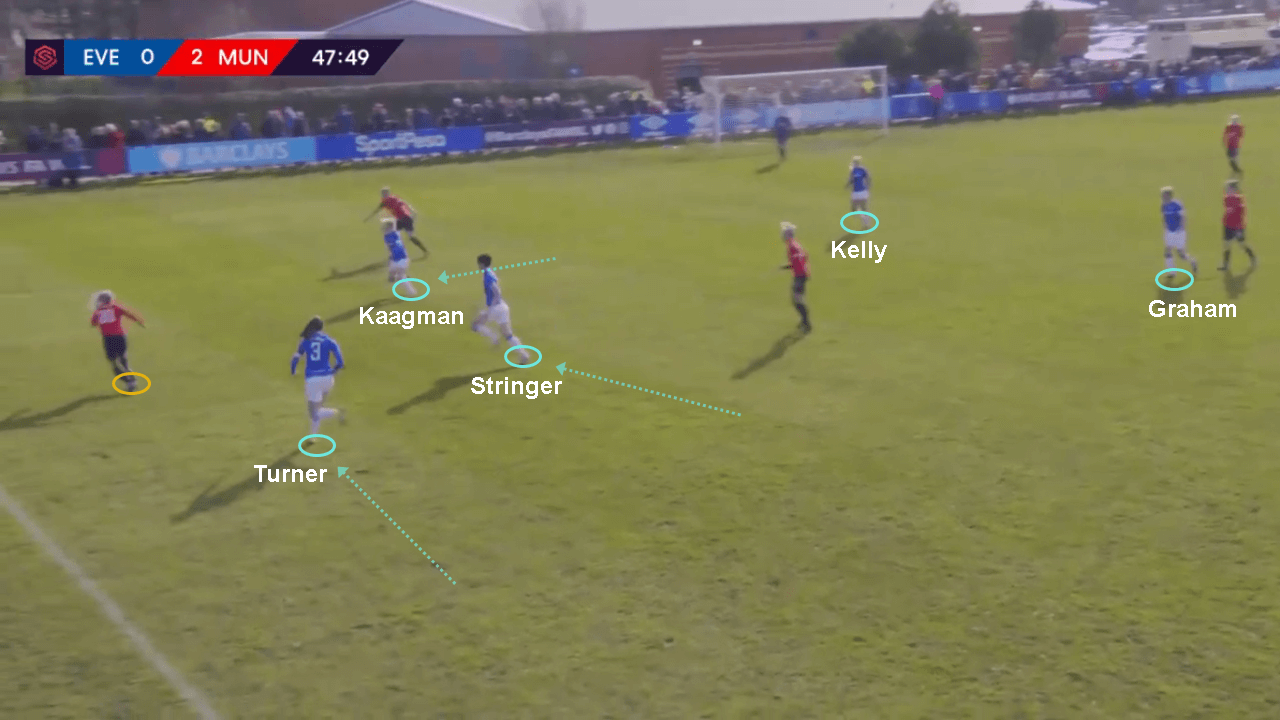
Gegenpressing from the forwards
Although Everton have four lines of pressure, as we explained, it is the constant work of the players surrounding the ball when it is in possession of the opponents that makes the press work. Otherwise it would be easy to bypass the individual lines of pressure with rotations in the midfield. The forwards for Everton work twice as hard defensively as they do offensively to deny opponents any time on the ball and immediately close down the space, forcing a pass backwards.
Here we see an instance where the Reading midfielder has won possession in front of her defensive line with some space to make a good decision as Everton is in defensive transition. But this space is immediately closed down by the attacking midfielder from the front and the centre forward who is tracking back from behind. This kind of gegenpressing from both sides forces the Reading player into losing the ball and Everton can initiate an attack again.

In these plots of recoveries by Everton in their game against Bristol City, Kelly (#11) played as a left attacking midfielder and Magill (#10) played as the centre forward. Notice the number of successful recoveries they have made in key areas of the pitch despite being Everton forwards. In fact, Simone Magill averages the highest number of duels per 90 minutes (33.22) in the FAWSL despite being a centre forward! This shows the defensive work-rate of the advanced players and its significance to Everton’s pressing game.
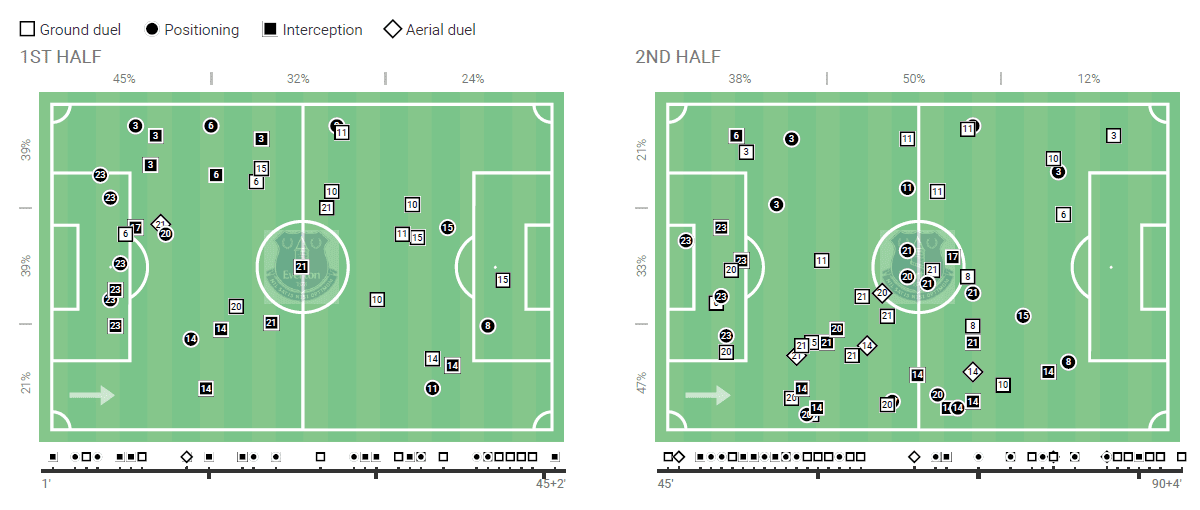
Consistency in pressing
Everton average the highest number of defensive duels won (74.90) per 90 minutes in the league winning 62% of their defensive duels. They also have the second-highest number of recoveries (81.29) per 90 with Clémaron, ranking third in the league for most number of recoveries by an individual player at 11.99 recoveries per 90. Everton are also second in the league for the number of interceptions (48.96) per 90 behind Bristol City.
If we rank their PPDA (passes per defensive action), they stand seventh with Reading, Chelsea and Manchester United taking the top spot. It is hard to understand how Everton’s pressing can be considered effective based on this ranking alone. But it makes a difference as to how we interpret the statistic. As discussed earlier, Everton do not engage in a high press all throughout the game, instead they pick the ‘right moments’ to press allowing the opposition wide players, such as the fullbacks to have more of the ball and play it back.
Comparing their PPDA over a few games, we see that they are able to engage in a relatively consistent press throughout the game. Here we see against Bristol City, Manchester United and Tottenham, the PPDA across 90 minutes is rather consistent. In fact the times when Everton have conceded is when their pressing intensity has dropped.

Other pressing systems
Against Arsenal, Kirk deployed a 5-4-1 system while they used a 4-3-3 against Brighton. Everton are able to use other formations to press, but the key principles remain the same. They close the spaces in the middle with a combination of man-marking and zonal-marking, they force the play wide to the opposition fullbacks, they close from all angles through the centre and they look for opportunities to push the defensive line up to suffocate the opposition.
In this graphic we see them utilising a deep block against Manchester City. This system comprised of a 4-3-2-1 with a midfield line of three closing the passing lanes in front of the defensive line with two advanced midfielders tasked at man-marking City’s double pivot and the lone centre forward to split the opposition from the top.
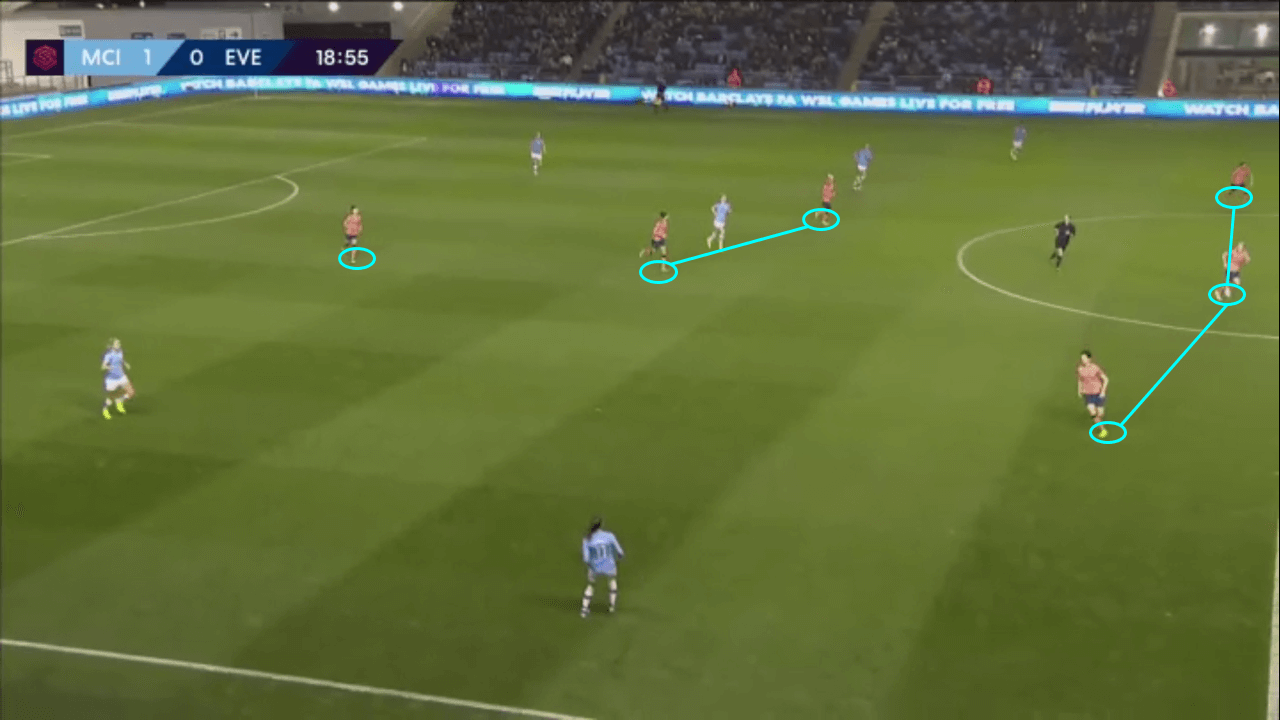
If you look at the graphic below, you see that although the formation is different, the pressing principles are the same. The centre forward splits the opposition centre-halves, the advanced midfielders below her man-mark the pivots in the half-spaces forcing the play out wide to the fullbacks, and the line of three midfielders close the passing lanes to the opposition forwards.

Everton currently lack the ability to transition effectively from defence to attack after winning possession from the press. They should be looking for an effective counter-attacking strategy to target the wide areas or attack the half-spaces on a turnover of possession. Haley Raso and Izzy Christiansen will play a vital role in the second phase of attacking transition after Kirk’s side are slowly mastering the art of the press in the FAWSL.
Conclusion
Willie Kirk has developed a great defensive system at Everton that manages to upset big teams in the league. Everton Women have ensured the success of this system with their relentless work rate from the forwards to the defence. With the quality of players in attacking transition, these pressing tactics can help Everton create better chances to convert turnover of possession in lucrative areas of the pitch into goals.




Comments